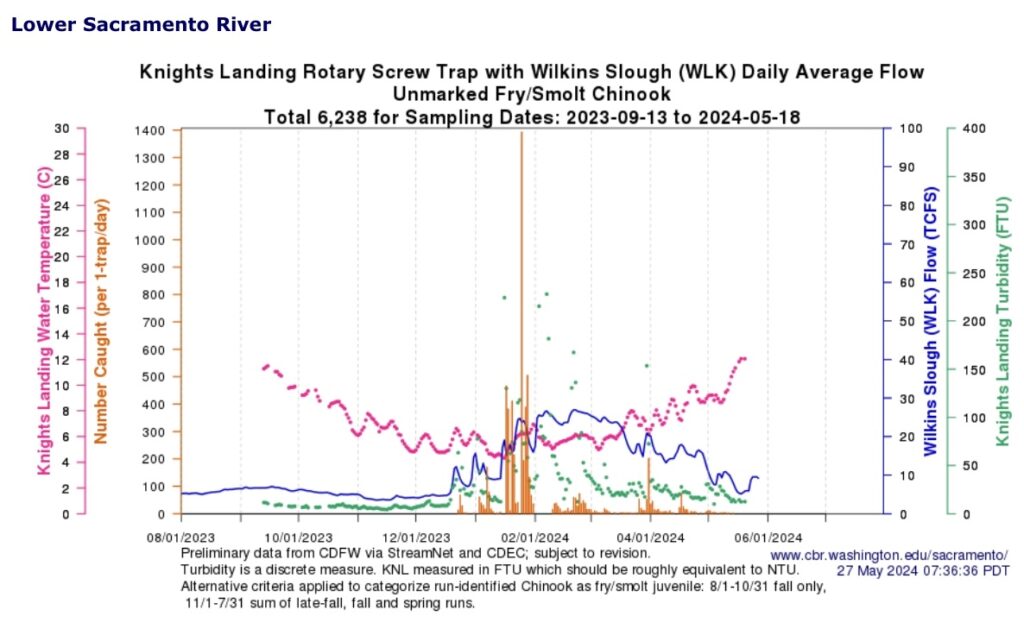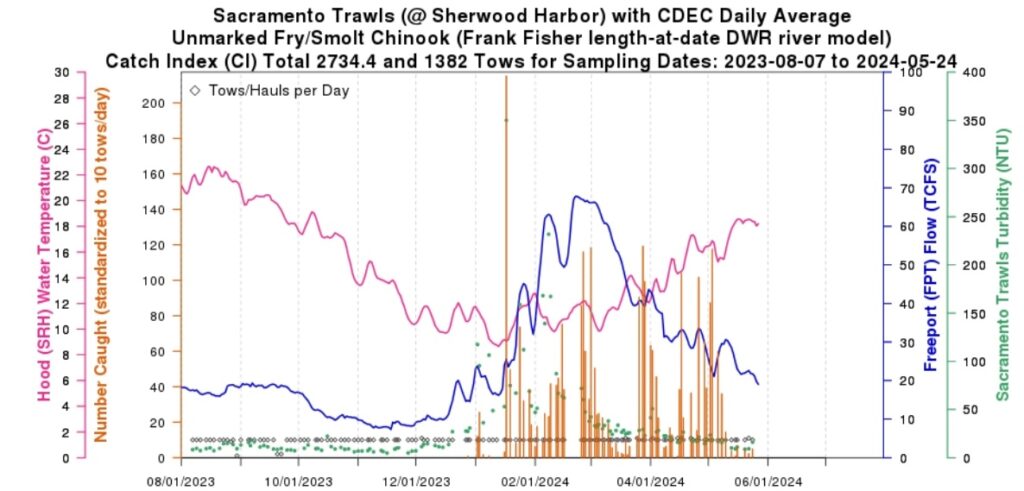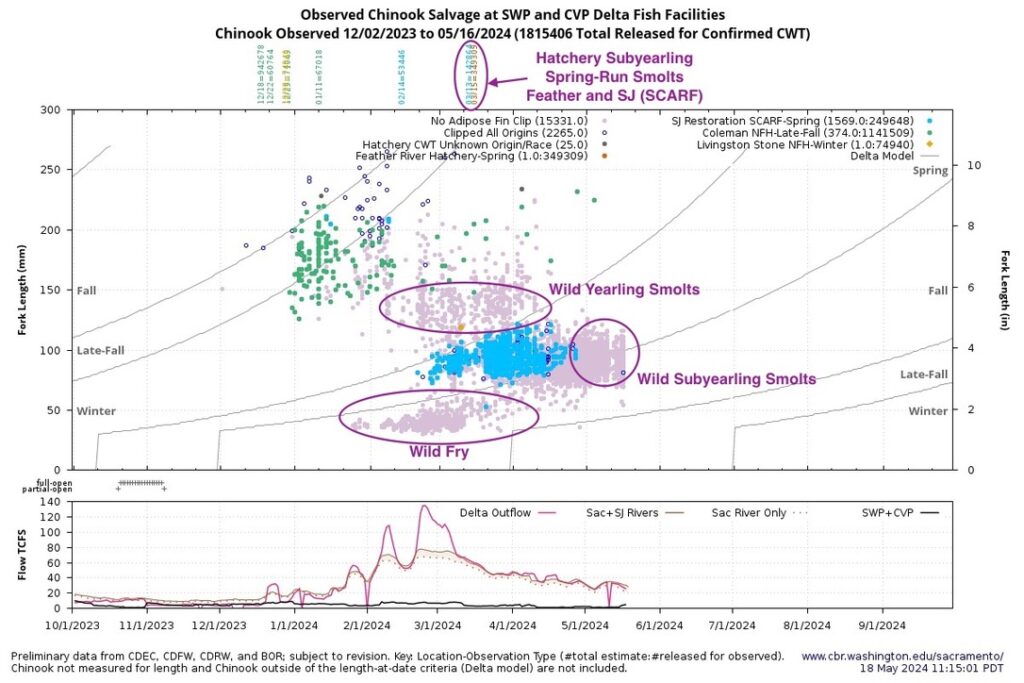In the third week of May 2024, the water temperatures in the lower Sacramento River recorded at Wilkins Slough increased to 72oF, well above the 68oF water quality standard (Figure 1). These warm water temperatures occurred in a wet spring of an Above Normal water year that is following a Wet water year.
The water temperature spike occurred between prescribed pulse flow releases from Shasta Dam in May (Figure 1). Three pulse flows were prescribed this spring to promote and assist migration of juvenile salmon into the lower Sacramento River and the Delta.
After the second pulse in early May, the lower river flow was allowed to drop to a drought-level 5000 cfs, causing the high water temperatures. Shasta Reservoir was virtually full at 4.3 MAF during all of May.
The Central Valley Basin Plan’s water quality objective for the lower Sacramento River is 68oF maximum “during periods when temperature increases will be detrimental to the fishery.” (P. 3-14). Declining tributary inflows and increased mainstem water diversions contributed to the low flows. Cooler American River and Feather River inflows to the Sacramento River below Wilkins Slough have kept north Delta water temperatures in the Sacramento River channel at Freeport and Rio Vista cooler at 64-67oF (Figure 2).
Many juvenile salmon emigrate to and through the Delta in spring (Figures 3-5). High water temperatures in the lower Sacramento River lead to a drop-off in migration and increase in stress and predation, ultimately reducing survival and the numbers of smolts reaching the ocean. Many spring-run and fall-run salmon smolts stay in the Delta through June and into July (Figures 6 and 7). A majority of these smolts are wild salmon adapted to emigrate with the late spring snowmelt season; they rear in the Delta prior to entering the ocean.
Adult spring-run and winter-run salmon also migrate upstream through the Bay-Delta to upriver spawning areas in the spring. They too benefit from the pulse flows, but also suffer stress from the high water temperatures on the journey upstream. Adult Chinook salmon avoid migration through water whose temperature is at or above 72oF.
Green and white sturgeon also spawn in the spring in the lower Sacramento River from Red Bluff downstream to Verona (river miles 200 to 100). Optimal water temperatures for spawning and early rearing are 50-65oF. Water temperatures above 65oF are stressful and lead to poor survival. Pulse flows stimulate spawning. Peak water temperatures of 68-72oF in mid-May are considered detrimental to juveniles and adults, as well as lethal to sturgeon eggs and embryos.
The river conditions described above for mid-May 2024 are typical in drought years, but not in wet years. The pulse flow certainly helps in the salmon and sturgeon migrations. But lower Sacramento River base flows should not be allowed to fall below the 8,000-10,000 cfs needed to maintain water temperatures at or below 65oF to protect migrating adult and juvenile salmon and sturgeon.
Wet-year recoveries are essential given how poor conditions are in drought years. The 2020-2022 drought led directly to the complete closure of salmon fisheries in 2023 and 2024 and more stringent requirements for the white sturgeon fishery in 2024.
Good migration conditions must be maintained in Wet years, including sequences of Wet and Above Normal water years, if there is to be any recovery from the multiyear droughts.

Figure 1. Daily-average Sacramento River flow and water temperature at Keswick Dam (RM 300) and Wilkins Slough (RM 120) in spring 2024. Note water temperature at Wilkins Slough (purple line) has exceeded the water quality standard of 68oF for the lower Sacramento River. Afternoon water temperatures on May 15 reached 72oF. Note the three pulse flows conducted by Reclamation (blue line) to support salmon migration helped to lower water temperatures. Note the sharp rise in water temperature in mid-May at Wilkins Slough after cessation of the second prescribed pulse flow, when streamflow dropped below pre-pulse flows.

Figure 2. Daily-average Sacramento River flow at Freeport (blue line) and water temperature a Freeport (green line) and Rio Vista (orange line) in spring 2024.

Figure 3. Rotary screw trap capture rate of juvenile salmon in 2024. Also shown is river flow rate and water temperature and turbidity.

Figure 4. Trawl Catch Index of juvenile salmon near Sacramento in the Sacramento River in Water Year 2024. Also shown is river flow rate and water temperature and turbidity.

Figure 5. Trawl Catch Index of juvenile salmon near Chipps Island in the eastern Suisun Bay in Water Year 2024. Also shown is river flow rate and water temperature and turbidity.

Figure 6. Salvage of juvenile salmon in water year 2023 at south Delta export pumping plants. Also shown are tagged hatchery salmon smolt collections by hatchery release groups and run type, and Delta flow and export rates.

Figure 7. Salvage of juvenile salmon in water year 2024 at south Delta export pumping plants. Also shown are tagged hatchery salmon smolt collections by hatchery release groups and run type, and Delta flow and export rates. Wild fry and smolt groups are noted; they can be segregated given the general lack of tagged hatchery smolts for the size group and time period.
